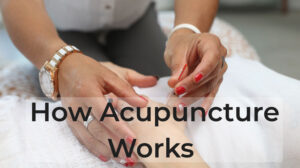The acupuncturist is the expert who performs acupuncture. He or she may employ needles or other devices, depending on the type, to achieve harmony and balance in the body.
Before you can proceed, you must first answer a few questions. Following that, a physical exam will be performed to check your pulse and evaluate the shape, color, and coating of your tongue. The color and texture of your skin, as well as your posture, will be checked as these will reveal clues to your health.
Only then will you be told to lie down on a padded examination table and have needles inserted into your skin. This needle differs in that it twirls and jiggles when it is inserted deeper into the body.
You may not notice the needles at all, or if you do, it will be a brief twitch. They will be left in place for 15 to 30 minutes, which may cause you to feel pretty calm and tired, even to the point of nodding off. When the session is over, the needles are removed and you are free to leave.
In certain cases, acupuncture is more effective when the needles are heated beforehand. This practice is known as moxibustion. A little bunch of the dried herb known as moxa or mugwort is ignited and placed over the needles by the acupuncturist. The herb, which burns slowly and creates a light smoke as well as a pleasant, incense-like odor, will never come into contact with your skin.
Acupuncture with electricity is another option. A weak current runs through the needles via electrical connections, causing no or little sensation.
To ensure the success of your therapy, the acupuncturist may also prescribe herbs.
When searching for an acupuncturist, make sure they are fully qualified. Before receiving one, he or she must first complete three years of training at a recognized oriental medicine university.
There are a few questions you should ask an acupuncturist other than their credentials. You should be knowledgeable about the many styles of acupuncture, as some do not use needles to treat patients.
Despite the fact that no studies have been undertaken to show that one technique is preferable to the other, some patients prefer one over the other.
Another question you should ask and further explore is how long the treatment will last. Patients with chronic illnesses will need to be treated for months before any obvious improvements can be seen. This will help you plan your schedule because you must visit the clinic 2 to 3 times every week.
Acupuncturists, like doctors, are there to make you feel better. If you are not making progress with this expert, you may need to seek the help of another specialist.
Types of Acupuncture
Acupuncture is available in a variety of formats. Whatever you select, the goal is the same: to alleviate pain or treat specific illnesses.
TCM-based acupuncture is the first type. To establish physical harmony, it employs eight notions of complementary opposites. Yin/yang, internal/external, excess/deficiency, and hot/cold are a few examples.
French energetic acupuncture is the next type of acupuncture. This is widely used by MD acupuncturists. Meridian patterns are highlighted here, notably yin-yang pairs of main meridians.
Another type of acupuncture is Korean hand acupuncture, which practitioners believe has qi concentrations in the hands and feet and that inserting acupuncture needles into these areas is beneficial to the entire body.
Auricular acupuncture is also used since the ear is regarded to be a microcosm of the body. To treat certain addiction disorders, acupuncture needles are inserted into specific sites on the ear.
Myofascial-based acupuncture is widely used by physical therapists since it involves feeling the meridian lines for uncomfortable places before providing needles because this is where aberrant energy flows.
In diagnosis, Japanese acupuncture treatments known as “meridian therapy” lay a stronger emphasis on the needling technique and perceiving meridians.
Electromagnetic energy impulses can also be exploited since the body produces tiny electrical discharges that affect the function, growth, and maturity of specific cell types. By inserting needles into specific areas of the body, neurotransmitters are stimulated and changed, allowing the patient to feel better after therapy. This is also used for diagnostic and testing purposes at times.
Acupuncture is also possible without the use of needles. To treat a patient, sonopuncture, for example, uses ultrasound equipment to deliver sound waves to specific places on the body. Some practitioners utilize a tuning fork or other vibrating devices.
Acupressure is another option. In this scenario, the specialist will relieve the discomfort with their hands. This can be used alone or in combination with other manual healing treatments.
The number of treatments required is determined by the condition of the patient. On average, this might be 10 to 5 treatments each month, 2 to 3 times per week. The price also fluctuates, with estimates ranging from £40 to £150. Some insurance companies now cover it entirely or partially, so check your policy to see if this is covered.
Which type of acupuncture should you try? That is all up to you. All of them are successful, so consult with your doctor and do some research so you know what you're getting yourself into. Each of these operations is painless, so simply relax and leave the rest to the pros.
As with traditional medicine, don't anticipate immediate results; it takes time, so keep an open mind.
This article was brought to you by www.orientalmedicine.co.uk
The post Acupuncturists: What Can They Do For You? appeared first on https://buydroppeddomains.com
The post Acupuncturists: What Can They Do For You? appeared first on https://wookicentral.com
The post Acupuncturists: What Can They Do For You? appeared first on https://gqcentral.co.uk







Comments are closed